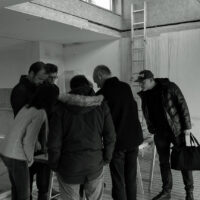Bijlmer City
Published as De laatste Bijlmerflat on: website De Architect, 2016
 Late last year I attended a special and perhaps historic event. There was a celebration in the Kleiburgflat in Amsterdam Bijlmermeer. To mark the founding of the so-called Kleiburg Monastery, the monks donated self-brewed monastery beer. The venue was the wide gallery on the second floor of this long, concrete apartment building, the once-despised and failed dry run to the once life-threatening parking garages. That very place was crowded. With sticks and plastic sheeting, the windy dry walk of yesteryear had been turned into a party tent.
Late last year I attended a special and perhaps historic event. There was a celebration in the Kleiburgflat in Amsterdam Bijlmermeer. To mark the founding of the so-called Kleiburg Monastery, the monks donated self-brewed monastery beer. The venue was the wide gallery on the second floor of this long, concrete apartment building, the once-despised and failed dry run to the once life-threatening parking garages. That very place was crowded. With sticks and plastic sheeting, the windy dry walk of yesteryear had been turned into a party tent.
Seven flats on the wide gallery were consecrated as monasteries. The balconies at the back were linked together. One of the seven flats contains a kitchen, a community room, guest rooms and a chapel and also has ground-floor access. There are plans for a monastery garden near the building. Not much later I visited the Kleiburgflat again, this time with the editors of the Architecture Yearbook. Architect Kamiel Klaasse enthusiastically talked about his renovation plan. Effortlessly, he proved that the architecture of these enormous buildings had been worked out in detail. The rough gravel concrete of the parapets has miles of refined wooden handrail and contains a small window.

Architect Jan van Grunsven showed how he is remodeling his own home. Like the monastics, he is realizing a unique, personal living environment. He had a huge skylight made. Beneath it he had consecrated a table with the models of his house and the results of his years of studies of the Bijlmermeer.
What is the secret of this success? First of all, it has to do with the depreciation of the corporation’s property. The developer bought the Kleiburg flats for one Euro and renovated the shell. The buyers of the flats themselves provide the investments needed to make the building habitable, in time, labor and money. But that is not the whole answer. Three years ago I spoke to German architect Hans Kollhoff about the future of the postwar city. His answer was firm. He would not invest a cent in that, in improving those ramshackle post-war reconstruction flats. That lack of faith is alien to Kamiel Klaasse, Jan van Grunsven, the residents of the Kleiburg monastery and the other private investors. Their faith in the Bijlmermeer is one of the other success factors of the Kleiburg Flats. There is much to learn from Kamiel Klaasse’s unbridled enthusiasm and Jan van Grunsven’s patient studies of the vitality of the postwar Bijlmer City.